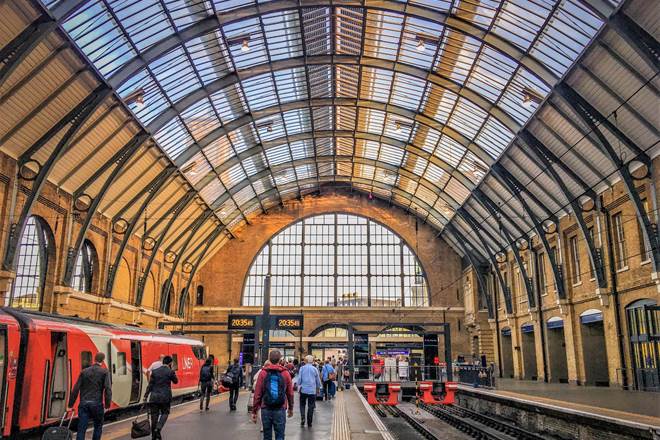Not only does it save time and CO2 by avoiding trips to the airport, but taking the train versus a flight is one of the more sustainable ways to travel. Travelling by train instead of a plane creates 7x less CO2[1]. So, switching to train is one of the single best things you can do to lower your CO2 emissions.
Are you wondering how to travel more sustainably but aren’t sure where to start? Swapping just one plane journey to a train is one of the best choices you can make to be more of a green traveller. While you may be less familiar with train trips across Europe versus hopping on a plane from let’s say, Gatwick to Nice, let us help you discover a handful of unexpected rail routes across the Continent.
London to Brussels by Eurostar: approximately 1 hour and 53 minutes
Image credits, iStock,Olrat. Location, Brussels, Belgium.
While Eurostar’s London to Brussels journey is often overlooked for its more established route from the capital’s St Pancras station to Paris, Belgium has a lot on offer. In a mere two hours (yep, you read that correctly), travellers will find themselves in the heart of Europe, flanked by the country’s much-loved cities of Ghent, Bruges, and Antwerp, which can be reached by regional trains in about an hour. A charming weekend getaway from London by train, soak up the sights of the UNESCO-listed The Grand-Place in Brussels before making new friends at Bar Ran, a cosy cocktail spot in the centre of Bruges, which is nicknamed the Venice of the north.
Paris to Milan: approximately 6 hours and 41 minutes
Image credits, iStock, Saiko3p. Location, Milan, Italy.
Trenitalia's high-speed train from Paris to Milan is one of the newer European routes ramping up this year. On most days, there is a morning and afternoon departure starting in the City of Light before heading south to Lyon and coasting across The Alps before finishing in Italy’s fashion capital. Not only are the panoramic views something to behold, but most of the trains on this route are also run on the Frecciarossa 1000 model, which is known for its swiftness – a maximum speed of 300 km/h can be reached in four minutes. These super-fast trains also have a low environmental impact and come complete with a wide range of amenities such as electrical and USB sockets, top-notch WiFi, and a bar car stocked with Italian favourites like Illy and Peroni.
Amsterdam to Vienna by sleeper train: approximately 13 hours and 41 minutes
Image credits, iStock. Location, Amsterdam, Holland.
Sleeper trains are picking up steam post-pandemic as travellers opt for new flight-free options. While more slow travel routes will be launching across the continent in the coming years, plenty of existing journeys cover a sizable distance across Europe while you catch some shut-eye. If there is a lot of country-hopping on your travel itinerary, this route is a brilliant choice for recharging before starting off on your next city adventure. Trains depart from the centre of Amsterdam each evening at 19:30 before coasting through Germany (Dusseldorf, Frankfurt, and Linz are a few cities on the way) and wrapping up in Vienna around 9:00 the next morning. Three accommodation options are available, including the main seating carriage, multi-bed couchette carriages, and sleeper cabins.
Hamburg to Stockholm by sleeper train: approximately 13 hours
Image credits, iStock. Location, Stockholm, Sweden.
The newest kid on the block is SJ EuroNight’s Hamburg to Stockholm service, which launched its highly anticipated route this past September. It’s been decades since there were direct train connections from Germany to Sweden, and now this intercity service leaves Hamburg-Altona (be sure to note this isn’t the city’s main station of Hamburg Hbf) just shy of 22:00 and arrives at Stockholm’s C station the next morning at 9:22 with around ten stops in between, including Copenhagen and Malmö. At the moment, there are only shared couchette cabins available, but the train operator is expected to add private sleeper cabins before the end of the year.
Swap to train and save the planet one journey at a time
Swapping to train is one of the biggest impacts you can make on your carbon footprint2, and we think that’s pretty amazing. So, join us in moving just one journey a year you would otherwise have taken by car or plane, to rail.
Header Image credits, iStock. Location, Kings Cross London, England.
See www.icamebytrain.com/FAQs for the facts
[1] Calculations are based on CO2 per passenger kilometre using statistics and conversion factors in the government’s greenhouse gas reporting conversion factors published 2 June 2021 and revised in January 2022.
Plane = Domestic flight with radiative forcing 0.24455 kg CO2 per passenger kilometre. 0.0351 x 6.97 = 0.24455. Plane emissions are 6.97 times greater than train emissions.
Train = National Rail 0.0351 kg CO2 per passenger kilometre.
0.0351 x 6.97 = 0.24455. Plane emissions are 6.97 times greater than train emissions.
[2] https://www.thetrainline.com/terms/sustainability-faqs

